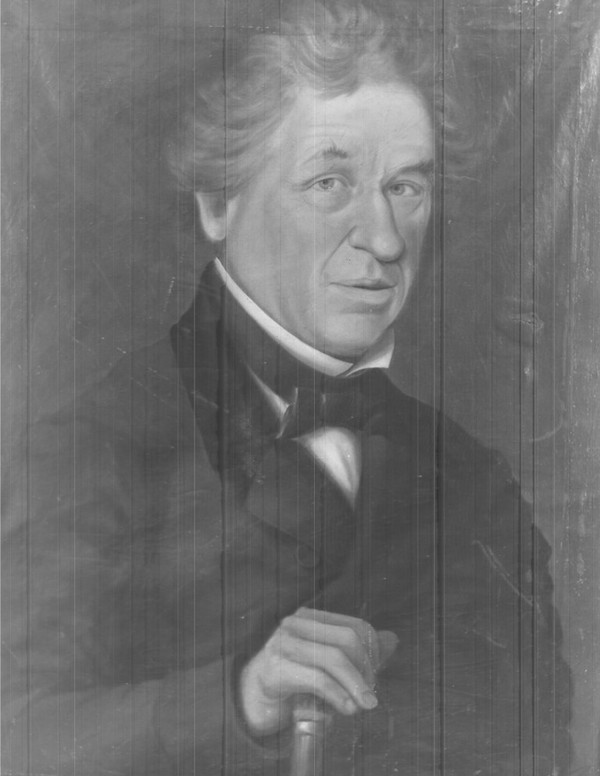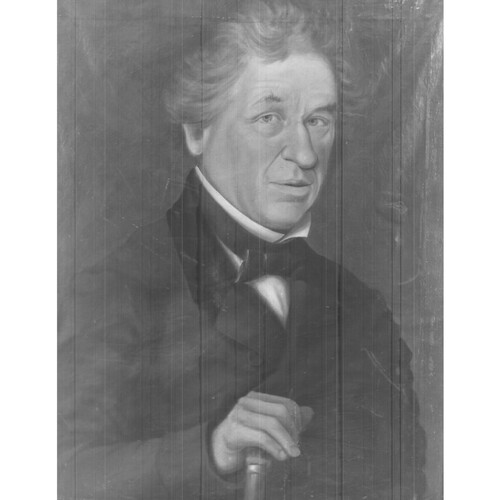
Source: Link
CHILD, MARCUS, businessman, office holder, justice of the peace, school administrator, and politician; b. December 1792 in West Boylstone, Mass.; m., probably in 1819, Lydia F. Chadwick of Worcester, Mass., and they had two children who survived infancy; d. 6 March 1859 in Coaticook, Lower Canada.
In 1812 Marcus Child moved to Stanstead, Lower Canada, from Derby Line, Vt, where he had been clerking for a merchant uncle the previous year. In Stanstead, Child prospered as a druggist, and began to take an interest in politics. He was one of the few residents of the Eastern Townships to speak out against the proposal of 1822 for the union of Upper and Lower Canada, and in 1829 he was elected to the House of Assembly as a reformer for the newly created two-member constituency of Stanstead. In 1830 he became postmaster for Stanstead and commissioner of the peace for the districts of Montreal and St Francis. Citing the long absences from his family as the reason, he declined to defend his seat in the general election that year.
Child was a school visitor from 1815 to 1840 and a trustee of the local school of the Royal Institution for the Advancement of Learning from 1822 to 1829. His major contribution during the session of 1829 was to acquire financial aid for the founding of Stanstead Seminary and Charleston Academy, the first two secondary schools in the Eastern Townships. During the 1830s he became a trustee and secretary of the seminary, as well as secretary of the Stanstead County Bible Society.
Deciding to return to politics, Child presented himself as a candidate for Stanstead in a by-election held in December 1833. Although the returning officer declared Wright Chamberlin the victor on the grounds that many of Child’s supporters were not qualified to vote, this decision was overturned by the assembly and Child took his seat in February. He only had time to vote for the 92 Resolutions drafted by Augustin-Norbert Morin* before appearing on the radical ticket for Stanstead in the fall general election. A friendly newspaper, the St. Francis Courier and Sherbrooke Gazette, claimed that he was “by no means a polished orator, or calculated to shine in debate, as but few men are, but is capable of expressing himself with ease, force and clearness.” His opponents, Chamberlin and Elisha Gustin, ran as moderate reformers but Child and his running mate, a Hatley farmer named John Grannis, nevertheless received the majority of votes.
During the sessions of 1835–36 Child was appointed a member of the assembly’s permanent committee on education and schools, established to inquire into the state of education in the province. He continued to give active support to Louis-Joseph Papineau*, attacking the British American Land Company formed in 1834 and heading an inquiry in 1836 which condemned the conduct of Sheriff Charles Whitcher, a member of the Tory clique surrounding landowner William Bowman Felton* of Sherbrooke. Unfortunately for Child, however, the region’s ardour for the Patriote party was cooling. In 1835 the assembly had seized upon a technicality to reject a petition for a vital project which Child himself had been promoting – a railway from Boston through the district of St Francis to Montreal. Moreover, a pronouncement by Papineau about an extension of the seigneurial system into the townships led to repeated predictions in the Tory press about the implications for Anglo-Protestant farmers. Residents of the townships became acutely aware of their dependency upon the French-speaking, Catholic majority in the assembly. The report in May 1836 of a special commission of inquiry, headed by Lord Gosford [Acheson*] and charged with investigating the conflict between the assembly and the executive, shrewdly observed that the radical representatives of Stanstead and Missisquoi were not elected to defend the “feudal system” and the French language, or to object to the establishment of land registry offices, but to oppose a government “which neglects or regards with disfavour” settlers from the United States.
In January 1837 a by-election was held to replace Grannis. Despite the unpopularity of the crown’s land policies, the assurances of Edmund Bailey O’Callaghan* that the French Canadians were opposed to the seigneurial system, and Child’s pledge that he would consider the vote a test of confidence, the radical candidate was decisively defeated by Moses French Colby*. Child, however, not only refused to resign but persisted in his political allegiance. In late November of that year he apparently even assisted some Patriotes to cross the border secretly. His dismissal as postmaster shortly thereafter, however, seems to have shaken him: one of the Patriote organizers in the United States, John B. Ryan*, wrote in January 1838, “He worships his property too much to jeopardize his safety by doing anything or even saying anything to advance the interests of the sacred cause.” Nevertheless, Child refused to take the oath of allegiance, on the grounds that he had already done so in the fall of 1837, and in November 1838, after being discharged as commissioner of the peace, he fled to Vermont to avoid arrest.
Child’s exile was brief, and during the early 1840s he became a merchant, potash manufacturer, and carding-mill operator in the village of Coaticook, although he remained a resident of Stanstead. Child defeated Colby in the election of 1841, and in the assembly of the united Province of Canada he actively promoted agricultural policies. At one time a leading proponent of free trade, he was forced by the American tariffs of 1842 to switch to protection for Canadian agricultural produce. Attacking the timber trade as morally debilitating, he favoured the extension of the agrarian frontier by the construction of good colonization roads and the improvement of municipal government. He also obtained protection for spawning maskinonge and salmon in Stanstead, Sherbrooke, Missisquoi, and Shefford counties, though the legislative committee did not recommend extension of this legislation to all freshwater fish in Canada, opting rather for local initiative. Such a recommendation was consistent with Child’s laissez-faire liberal philosophy, as was his support in principle for free tuition while he opposed provincial taxation of those municipalities refusing to tax themselves for school purposes. But he was not so opposed to the centralization of power when it came to his personal interest. He lobbied to have the Post Office Department made directly answerable to the Executive Council. He was not motivated simply by political principle; he was also seeking revenge against his dismissal in 1837 by Postmaster General Thomas Allen Stayner*. In fact, a growing conservatism can be discerned in Child’s conversion from Methodism to Anglicanism and in his defence of Canadian textbooks in lieu of the popular American imports which had “injurious effects” because of their support for republicanism and democratic ideas. It is not surprising, therefore, that he pledged his allegiance to Governor Sir Charles Theophilus Metcalfe* when Robert Baldwin and Louis-Hippolyte La Fontaine* resigned over the issue of responsible government in November 1843. His constituency was not appeased, however, for in 1844 it elected John McConnell, an uncompromising government supporter, by a strong majority.
Child nevertheless became senior magistrate for Stanstead County as well as inspector of schools for the district of St Francis in 1845, holding the latter position until his death. He controlled local patronage after the Baldwin–La Fontaine victory of 1848, but suffered a crushing defeat at the hands of lawyer Hazard Bailey Terrill when he appeared on their slate in 1851. This was the last time he ran for public office. His interests in Stanstead remained important enough for him to support a railway through that village in 1852, but after Sherbrooke and Coaticook won the route for the St Lawrence and Atlantic Rail-road, he joined the migration to the latter town in 1855. In 1859, after a short illness, he died there of inflammation of the lungs.
ANQ-E, CE1-41, 9 mars 1859. PAC, MG 24, B1, 7; 132; MG 30, D1, 8; RG 4, A1; RG 68, General index, 1651–1841: 290, 394, 421. Private arch., Roger Jean-Marie (Coaticook, Qué.), B. N. Robinson, “The early history of Coaticook, from its foundation down to 1902” (ms, 1933). Stanstead County Hist. Soc., Colby-Curtis Museum (Beebe, Que.), Marcus Child papers. Can., Prov. of, Legislative Assembly, Journals, 1852–53. Debates of the Legislative Assembly of United Canada (Abbott Gibbs et al.), vols.1–3. L.C., House of Assembly, Journals, 1834–36. Missiskoui Standard (Frelighsburg, [Que.]), 1835–39. Montreal Gazette, 3, 10 Dec. 1829; 19 Jan. 1837; 17, 20 Nov., 6 Dec. 1838; 27 March, 1 April 1841; 5 Oct., 7, 9 Nov. 1844. St. Francis Courier and Sherbrooke Gazette (Sherbrooke, [Que.]), 2 Oct. 1834. Stanstead Journal (Rock Island, [Que.]), 4–18 Dec. 1851, 4–11 Feb. 1858, 10 March 1859. Vindicator and Canadian Advertiser (Montreal), 17, 20 Nov. 1829; 31 Jan. –25 Feb., 10 Oct., 14 Nov. 1834; 7–27 Jan. 1837. Cyclopædia of Canadian biog. (Rose and Charlesworth), 2: 647–48. Fauteux, Patriotes, 178–79. Albert Gravel, “Marcus Child” (paper delivered before the Stanstead County Hist. Soc., Beebe, 1963). B. F. Hubbard, Forests and clearings; the history of Stanstead County, province of Quebec, with sketches of more than five hundred families, ed. John Lawrence (Montreal, 1874; repr. 1963). “An address by Marcus Child,” Stanstead County Hist. Soc., Journal (Stanstead, Que.), 6 (1975): 16–24. “The story of Stanstead College since 1817,” Stanstead County Hist. Soc., Journal, 3 (1969): 49–56.
Cite This Article
J. I. Little, “CHILD, MARCUS,” in Dictionary of Canadian Biography, vol. 8, University of Toronto/Université Laval, 2003–, accessed January 6, 2025, https://www.biographi.ca/en/bio/child_marcus_8E.html.
The citation above shows the format for footnotes and endnotes according to the Chicago manual of style (16th edition). Information to be used in other citation formats:
| Permalink: | https://www.biographi.ca/en/bio/child_marcus_8E.html |
| Author of Article: | J. I. Little |
| Title of Article: | CHILD, MARCUS |
| Publication Name: | Dictionary of Canadian Biography, vol. 8 |
| Publisher: | University of Toronto/Université Laval |
| Year of publication: | 1985 |
| Year of revision: | 1985 |
| Access Date: | January 6, 2025 |



